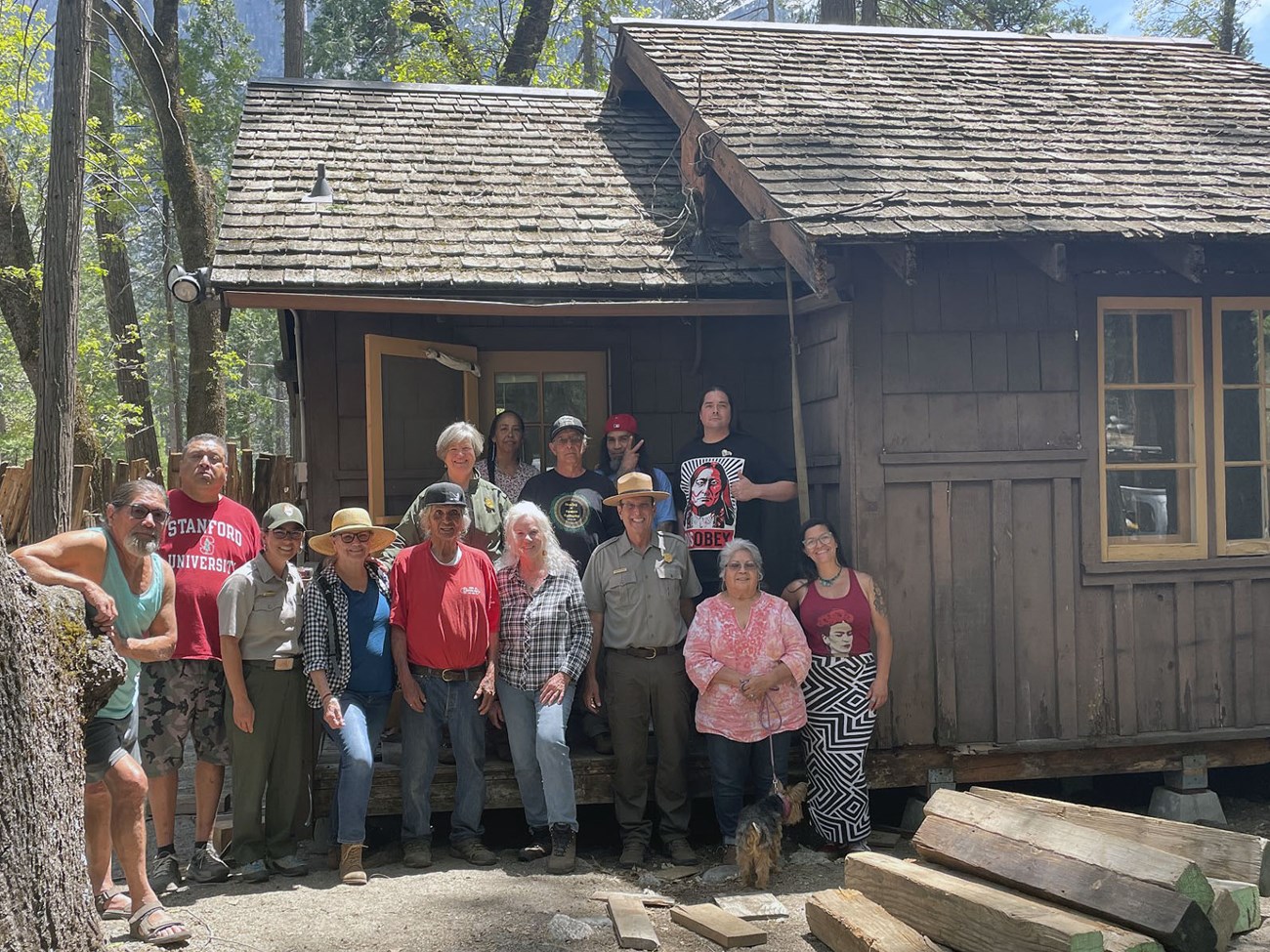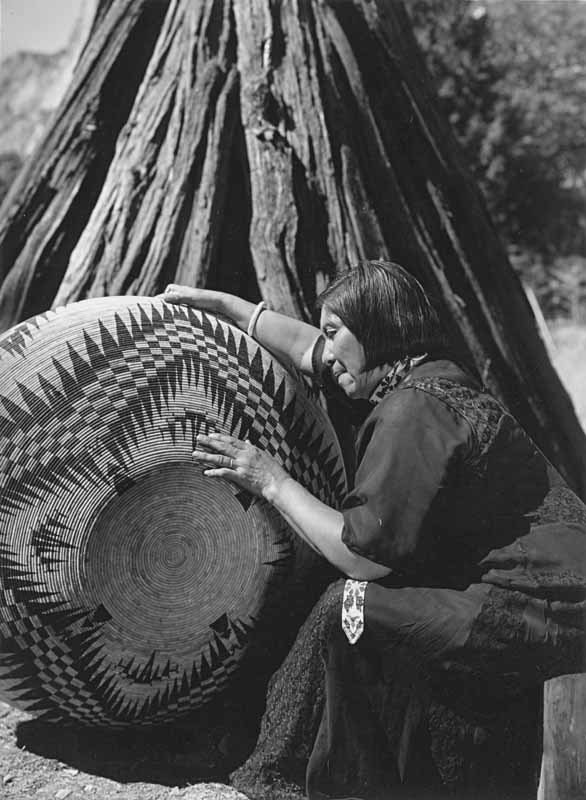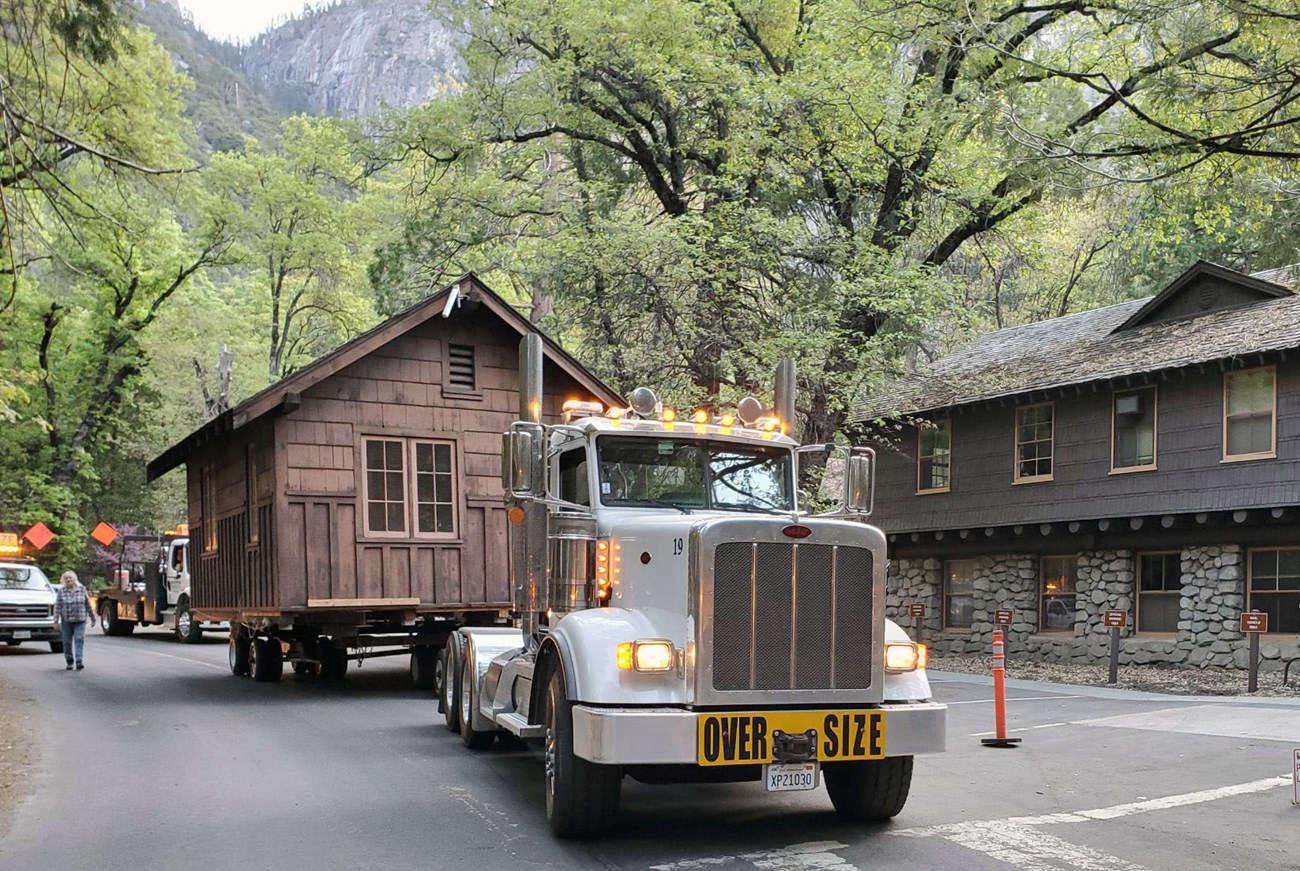Last updated: July 8, 2024
Article
Yosemite's Wilson Cabin Move, a Restoration 50 Years in the Making

NPS Photo
Written by Anna Christie, historian
Dino Brochini remembers picking sour berries in Yosemite when he was young, selling them to tourists for a dollar a bag. “We went up there and we planted small baby oaks in the meadow and gathered acorns,” he says, illustrating his connection with the land. Dino is a member of the Southern Sierra Miwuk Nation (SSMN), also known as the American Indian Council of Mariposa County, and serves as Chairman of the Wahhoga Committee. The Tribe is one of seven traditionally associated tribes of Yosemite National Park. His ancestors, as recently as his father, lived in a village in the park.
Dino Brochini remembers picking sour berries in Yosemite when he was young, selling them to tourists for a dollar a bag. “We went up there and we planted small baby oaks in the meadow and gathered acorns,” he says, illustrating his connection with the land. Dino is a member of the Southern Sierra Miwuk Nation (SSMN), also known as the American Indian Council of Mariposa County, and serves as Chairman of the Wahhoga Committee. The Tribe is one of seven traditionally associated tribes of Yosemite National Park. His ancestors, as recently as his father, lived in a village in the park.
-
Dino Brochini - Connection
Regional Partnerships and Cultural Resources Awards interview with Dino Brochini and Jazzmyn Gegere Brochini of the Wahhoga Committee, Southern Sierra Miwuk Nation
- Date created:
- 04/19/2024
By 1969, the National Park Service (NPS) had evicted his ancestors from their homes, burning the park-built cabins they had lived in since the 1930s. In the fifty years since then, the Tribe has led the effort to rebuild that area, now called Wahhoga Village, as a center for Tribal education, stewardship, and healing within their ancestral homeland.
2023 was a milestone year for the project. The Wahhoga Committee made significant gains in building a ceremonial roundhouse and moved the only surviving cabin, the Wilson cabin, back to its original location. In May 2024, the Pacific West Regional Office of the NPS awarded the Wahhoga Committee a Partnership Excellence award, in conjunction with a Cultural Resource Specialist award for Echo Davenport, Yosemite’s Archeological Compliance Program Manager.
2023 was a milestone year for the project. The Wahhoga Committee made significant gains in building a ceremonial roundhouse and moved the only surviving cabin, the Wilson cabin, back to its original location. In May 2024, the Pacific West Regional Office of the NPS awarded the Wahhoga Committee a Partnership Excellence award, in conjunction with a Cultural Resource Specialist award for Echo Davenport, Yosemite’s Archeological Compliance Program Manager.
Cultural Resilience
NPS is not the first “land managers, stewards, storytellers, or knowledge keepers” of Yosemite Valley explains Echo. “The privilege was not given to us but taken from the people and communities who came first.”1 Seven tribes have ancestors who lived in Yosemite Valley for thousands of years, caring for, shaping, and living off the land. Archeological excavations conducted in Wahhoga Village show that it has been inhabited for thousands of years.2American colonialism changed that. In the wake of statehood and the Gold Rush, the U.S. and California governments financed and allowed violence against Native Americans. In his 1851 State of the State Address, the first governor of California, Peter Burnett, said that a “war of extermination will continue to be waged between the races until the Indian race becomes extinct,” and that though regrettable, this was “the inevitable destiny of the race,” and “beyond the power or wisdom of man to avert.”3 Far from inevitable, the state Legislature paid for volunteer militias to “suppress Indian hostilities,” incentivizing violence against tribes throughout the state.4 Survivors were forced into labor and onto reservations, with many of their children kidnapped and raised in white households and later boarding schools.5
In spring of 1851, miners near Yosemite formed a state-sanctioned volunteer militia and entered the valley. Led by James Savage, they burned villages, captured, and killed Indigenous people, and brought survivors to a reservation in the San Joaquin Valley.6 In the decades that followed, a new environmental movement championed a vision of pristine wilderness, free of humans – which did not reflect the thousands of years of Indigenous care and connection with the land.7 Yosemite Valley became a national park in 1890 and visitors flocked to experience the “primeval” natural wonders.

NPS Collections/Yosemite National Park [RL002051]
Then in 1969, the NPS evicted the remaining residents and destroyed all the buildings except the Wilson Cabin, which was relocated and used as a park facility. “I have heard stories from people of when the houses were burnt down. And those are very, very difficult for me to hear,” shares Jazzmyn Gegere Brochini, Cultural Resource Preservation Department Director for the SSMN and Treasurer for the Wahhoga Committee. “But it needs to be heard because that’s part of the history.”
A New Vision of Co-Stewardship
“We want our village back,” SSMN Tribal members Les James and Jay Johnson told Yosemite’s superintendent and the NPS Western Regional Director in 1977.9The year after the 1969 eviction, members of the SSMN formed the American Indian Council of Mariposa County to advocate on the Tribe’s behalf with the NPS. They sought to establish a Tribal cultural center on the site of the village, a new vision for the national park land. In the last fifty years, it has been a struggle to fulfill this vision.
-
Jazzmyn Gegere Brochini - Vital Traditions
Regional Partnerships and Cultural Resources Awards interview with Dino Brochini and Jazzmyn Gegere Brochini of the Wahhoga Committee, Southern Sierra Miwuk Nation
- Date created:
- 04/19/2024
Echo characterizes Yosemite’s current role working with the Wahhoga Committee as a co-stewardship effort where indigenous management and NPS management overlap. In 2018, the park signed an agreement, acknowledging that evicting the Tribe severed a vital means of continuing their cultural practices and association with the land. The agreement outlines NPS and Tribal responsibilities. NPS agrees to do all compliance, establish utilities in Wahhoga Village, relocate a trail from the area, and protect the privacy of the Tribes while they are using the village.
On the Wahhoga Committee’s side of the agreement, they are responsible for fundraising, constructing, and maintaining the facilities. In 2023, they made substantial progress constructing a ceremonial roundhouse. They consulted with the Wenaha Group, an Oregon-based Native American engineering company for the design. It was built by an all-native crew from the Jackson Rancheria in Amador County, California. The Committee secured a grant from the National Trust of Historic Places, in addition to a substantial donation from Les James and his spouse, Maryann Green. With this financial support, they were able to move the Wilson Cabin to its original location.
On the Wahhoga Committee’s side of the agreement, they are responsible for fundraising, constructing, and maintaining the facilities. In 2023, they made substantial progress constructing a ceremonial roundhouse. They consulted with the Wenaha Group, an Oregon-based Native American engineering company for the design. It was built by an all-native crew from the Jackson Rancheria in Amador County, California. The Committee secured a grant from the National Trust of Historic Places, in addition to a substantial donation from Les James and his spouse, Maryann Green. With this financial support, they were able to move the Wilson Cabin to its original location.

NPS Photo
Wilson Cabin Returns to Wahhoga
Echo helps fulfill the NPS side of the bargain. She knows that the compliance and special use permit requirements are necessary but “cumbersome bureaucratic impositions in this Tribal-led effort.”10 She serves as a bridge between the Tribe and the NPS, using her knowledge of preservation law to navigate paperwork hurdles. She also coordinated with Yosemite’s many internal teams on the Wilson Cabin move.At six a.m. on a spring morning in 2023, a tractor trailer carried the three-room wooden cabin along one of Yosemite’s main roads. You would think that moving an entire building through the heart of one of the most popular national parks in the country would be challenging, but it went smoothly. The most difficult part of the project, Echo explains, was the “colonial circumstances between the park and the Tribes, and the grief that those circumstances elicit. But grief is not in our job description or workplans. We had thought that re-establishing a year-round Indigenous presence in Yosemite Valley and returning this building would be difficult. It took us over 50 years to learn how attainable reconciliation actually was.”
-
Dino Brochini - A Healing Place
Regional Partnerships and Cultural Resources Awards interview with Dino Brochini and Jazzmyn Gegere Brochini of the Wahhoga Committee, Southern Sierra Miwuk Nation
- Date created:
- 04/19/2024
The Future of Wahhoga
For Dino, Jazzmyn and the Southern Sierra Miwuk Nation, this is not history that you put on a shelf. The vitality of their culture comes from its resilience over the years, with elders who pass down their knowledge to the next generation, spoken in their language.The Wahhoga Committee continues to work toward the Elders' vision. They have secured funding from the Yosemite Conservancy and is working with them on plans for a caretaker’s cabin and a variety of other small projects. Their next step is to expand programs for education and ceremonial practices, with an invite to all local tribes. Also written into the agreement is a requirement that the park and Tribe meet annually to discuss Wahhoga Village and events taking place there, ensuring future collaboration and co-stewardship.
1 Interview with Echo Davenport, March 14, 2024.
2 Archeological Investigations at CA-MRP-305/H, Indian Cultural Center (Wahhoga), Yosemite National Park, Jackson, et al., 2016.
3 "State of the State Address," Peter Burnett, first governor of California, Jan. 6, 1851, California State Library, https://governors.library.ca.gov/addresses/s_01-Burnett2.html.
4 "A History of American Indians in California: 1849-1879," Five Views: An Ethnic Historic Site Surveu for California, California Department of Parks and Recreation, Office of Historic Preservation December, 1988, https://www.nps.gov/parkhistory/online_books/5views/5views1.htm.
5 "Laws of the State of California An act for the government and protection of Indians," April 22, 1850, Library of Congress, https://www.loc.gov/resource/cph.3c16681/.
6 "Destruction and Disruption," Yosemite National Park, Nov. 17, 2018, https://www.nps.gov/yose/learn/historyculture/destruction-and-disruption.htm.
7 West, Elliott, The Essential West: Collected Essays, pp.298-299. Cronon, William, “Landscapes of Abundance and Scarcity,” The Oxford History of the American West, pp.630-631.
8 Interview with Jazzmyn Gegere Brochini and Dino Brochini, April 19, 2024. Also stated in Final Report for “Six Cabins, Indian Village,” 1932, courtesy the Yosemite National Park archives.
9 Les James presenting to the Society for California Archeology, March 2017. Personal notes of Dawn Bringelson, Yosemite Supervisory Archeologist, April 18, 2024. Also retold by Jazzmyn in April 19 interview.
10 Interview with Echo Davenport, March 14, 2024.
